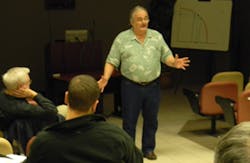Day 2: 5 Interesting Things I Heard Today at the Pump Guy Seminar
Jan. 17, 2013
Day 2 of this week’s Pump Guy Seminar in Decatur, Ala. is in the books—two down, one to go. Today the Pump Guy schooled attendees on the finer points of pump and system curve analysis, and you could virtually see light bulbs flashing on over the heads in the room. Here’s the second “5 Interesting Things” post from this week’s training. To read Day 1’s post, click here.
RELATED: Register Now for Early-Bird Rates for the Aug. 20-22 Pump Guy Seminar in Philadelphia
-
When operating your pump to the left of best efficiency, your pump is likely to overheat. As a matter of fact, all kilowatt consumption at shutoff head is converted into heat. This can cause the cold water to turn into steam within a few moments.
- Dual-volute pump casings will equalize the radial hydraulic forces around the pump impeller, expanding the operating window of the pump and relaxing the load on the pump’s radial bearings. As such, if failure analysis of your bearings indicate failure is in the radial bearing, then the dual-volute casing might be a good solution. On many pumps, the dual-volute casing is an option when you rebuild the pump so it can be added even if that is not how the pump was purchased.
- If you buy a “more efficient” pump and you don’t know and understand your pump curve, then you’re wasting your time and money. No matter how “efficient” the pump, if it’s not operated in the best efficiency zone indicated on the pump curve, then it will be inefficient.
- Operating a pump in the best efficiency range can ensure the pump achieves 100 percent of design life, whereas operating the pump at the extremes of the curve can reduce its design life to as little as 5 percent.
- The Total Dynamic Head (TDH) of a pump is composed of four different heads—static head, pressure head, friction head, and velocity head.
For more information about the Pump Guy Seminar and upcoming training programs, visit www.FlowControlNetwork.com/PumpGuy.
Sponsored Content



